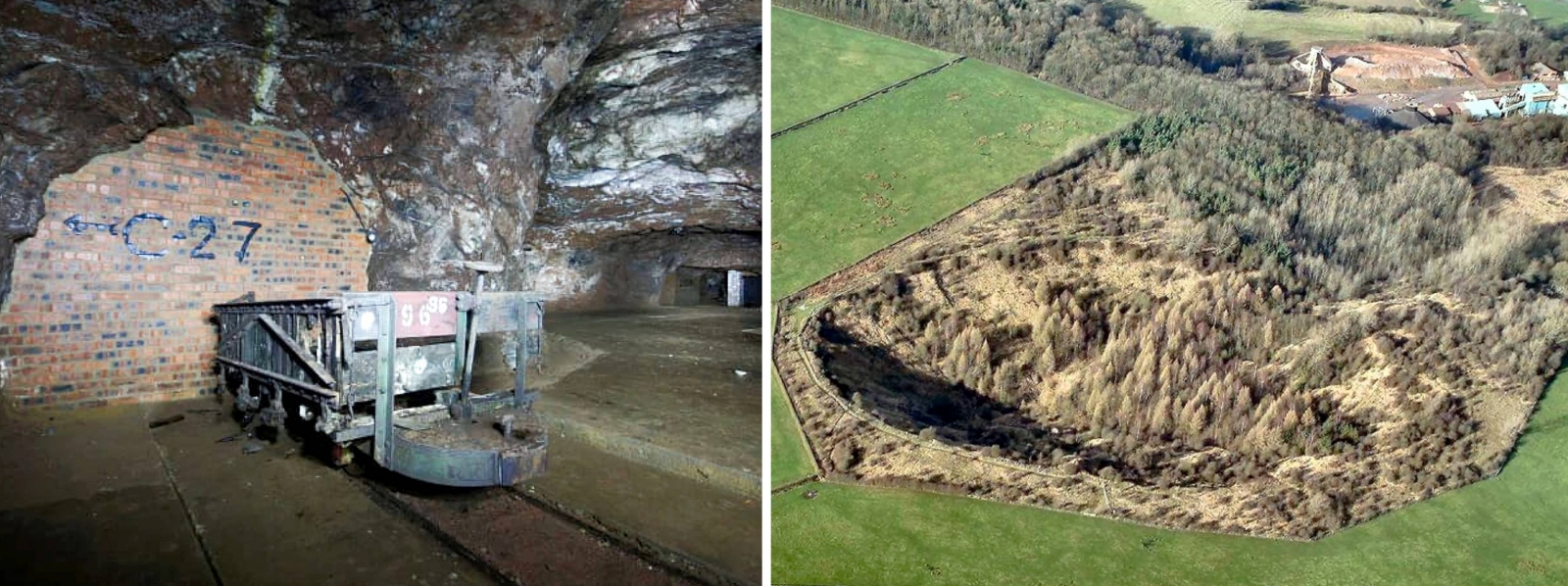The RAF Fauld explosion on 27th November 1944
Header Image: Aerial view of the crater at RAF Fauld after the explosion on 27th November 1944.
The two World Wars left indelible marks on the lands over which they were fought; from the scarring of the trenches of the Western Front in the First World War to the remnants of the Mulberry harbour off Arromanches, Normandy, in the Second World War. As we approach Remembrance Day this year it is worth reflecting on a scar on the landscape in a quiet corner of Staffordshire, which tells of the loss of many lives, military and civilian, eighty years ago this month on 27th November 1944, in a war-related accident.
In 1937 with war looming, the Air Ministry purchased 450,000 square feet of disused gypsum workings to be used for weapons storage, next to a plaster works near Hanbury, about 5 miles north east of Burton upon Trent. The site, which had tunnels 12 feet high and 20 feet wide, eventually became RAF Fauld. Here, 21 Maintenance Unit Bomb Storage Dump housed 24,000 tons of high explosive bombs plus incendiaries and detonators. It also acted as a repair centre for defective and jettisoned bombs. The Dump, as it was locally known, was shrouded in secrecy, but by 1944 over a thousand people were employed there, both RAF and civilian personnel, along with nearly 200 Italian prisoners of war. An underground railway network was constructed, linked to the mainline sidings at Scropton, and the bombs and ammunition were distributed by rail to the country’s wartime airfields, a vital supply of munitions for use in the war against Germany.

Shortly after 11.10 am on Monday 27th November 1944 two huge, almost simultaneous, explosions occurred at the dump, as around 3,800 tons of ordnance, mostly high explosives, blew up, creating one of the largest non-nuclear blasts ever recorded. Eyewitnesses reported seeing two distinct columns of black smoke in the form of a mushroom cloud climbing several thousand feet, with a blaze at its base. A crater, half a mile across and 100 feet (30 m) deep was created, mounds of earth weighing up to a ton in weight fell to the ground and a fine dust up to four inches thick fell all around.
Around a third of the RAF Fauld site was destroyed and in an instant 70 people were killed: 58 were civilians, six were RAF men and six were Italian prisoners of war working at the dump. Casualties in the bomb store itself were miraculously limited to 35 by the natural and man-made barriers in the tunnel system, which helped contain the effects of the explosion. Outside the immediate site Upper Castle Hayes Farm was completely obliterated along with its horses, cattle and six people. Virtually every house in Hanbury Village was severely damaged and several local people were killed. Meanwhile, a reservoir burst, flooding the adjoining actively mined areas with six million gallons of water, mud and debris, which caused the deaths of many workers by drowning. Six more deaths arose from toxic fumes. Of the dead, 18 people were never found and have no known grave.

The rescue efforts that day were heroic, as firemen, servicemen and members of the local mines rescue group battled flames in the maze of fractured tunnels, knowing that a stockpile of 10,000 bombs lay perilously close to the blaze and could also go up at any minute. Men who had only just managed to make their way to the surface, turned and plunged straight back in to look for survivors. Everybody in the small community piled in to help, showing outstanding courage
Afterwards, the damaged tunnels were sealed off, but the untouched section was deemed safe and continued to be used by the RAF to store ammunition and explosives until the 1970s. Immediately after the explosion the government was keen to hush up the disaster for reasons of national security. Outside of the local area, knowledge of the incident was limited until after the lifting of censorship in 1974. The findings of the secret 1944 inquiry revealed that the cause of the explosion was “in all probability” human error by a technician attempting to remove a live detonator from a steel bomb casing with an incorrect tool, causing a spark which set off the initial detonation and a chain reaction in a further 3,800 tons of bombs.

The explosion left a lasting mark on the Staffordshire landscape. The Hanbury Crater, as the explosion site is now known, has now largely been reclaimed by nature. A tranquil and beautiful walk is possible around the perimeter, but the site itself remains the property of the Ministry of Defence and still contains buried explosives, with signs forbidding entry. In 1990 a small memorial with the names of those killed was erected at the site and another memorial exists at the National Memorial Arboretum.

Eighty years on, it is right that we remember all those who tragically lost their lives in this wartime accident, including the six RAF men: Sergeant SG Game, Corporals AS Durose and L Scuto, and Leading Aircraftmen JT Bailey, HC Fairbanks and W Deucharas, who were amongst those unsung heroes “who also served”.
LEST WE FORGET







